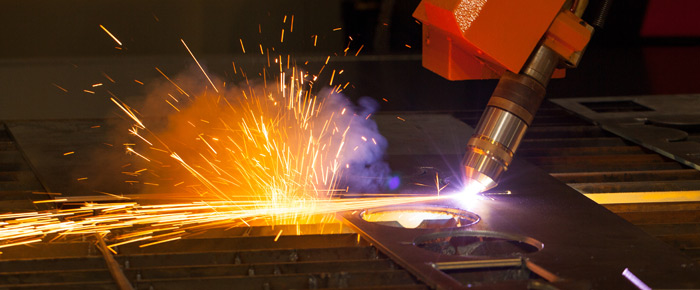Plasma cutting is a process that uses a jet of hot plasma to cut through nickel alloys, steel, aluminum, brass, copper and other conductive metals. Because of its high speed and precision cuts, plasma cutting has become a staple in the metals industry.
BACKGROUND CHECK! YESTERDAY…
The first plasma systems grew out of plasma welding in the late 1950’s but weren’t as efficient as what we have now. It used to take over 350 Amps to cut through ½” thick materials instead of the 50 Amps used today! At the time, all cuts required grinding to remove dross. Improvements through the years made it a very productive way to cut sheet metal and plate in the 1980s. It had the advantage over traditional cutting because it produced no metal chips, made accurate cuts, and left a cleaner edge. Yet because they were expensive and somewhat slow, these early plasma cutters were used mostly in mass production.
In the late 1980s and early 1990s, CNC technology was applied to plasma cutting machines. Along with long life oxygen cutting technology, high flow vortex nozzle, and the introduction of high definition plasma, these machines had greater flexibility.
…BRINGING YOU TO TODAY! THE MOST CURRENT…
Now we need the most current technology because high productivity is imperative in today’s marketplace. The beveled edge must meet certain requirements such as dimensional consistence and adequate surface dictated by the application. Material and welding time are wasted if there is an inconsistent bevel angle and bevel depth. Today’s market demands consistent weld joint dimensions because of an increased need for efficiency and cost reduction.
Compound Skew – Plasma often is used for automated bevel cutting because of its potential for high cutting speeds and cut quality. The plasma torch rotates and tilts to achieve the proper bevel angle. In addition to the rotary, or C, axis, a tilt, or A, axis can be added for contour plasma bevel cutting. The CNC commands the A axis to tilt the plasma torch to the appropriate bevel angle. A compound-skew design uses rotary motion to tilt the plasma torch. The CNC coordinates this A-axis motion with simultaneous C-axis motion, providing the proper torch angle while maintaining the bevel position tangent to the direction of travel.
At Corrosion Materials, our high definition CNC plasma equipment can accurately cut and bevel profiles on almost any contour. The beveled plate cut on our machine is typically used to create bevels for weld-preparation surfaces. Bevel and land edge configurations can be created via multiple passes.
We specialize in processing squares, rectangles, strips, circles, rings and custom per print shapes. Having us cut your V, K, X and Y weld prep bevels for you can reduce bottlenecks and save time, material and weld wire. Whether you have a large custom order or individual pieces, let us help you get exactly what you need. We work with clients in industries around the world to fill their orders with the high standards they’ve come to expect from Corrosion Materials.

